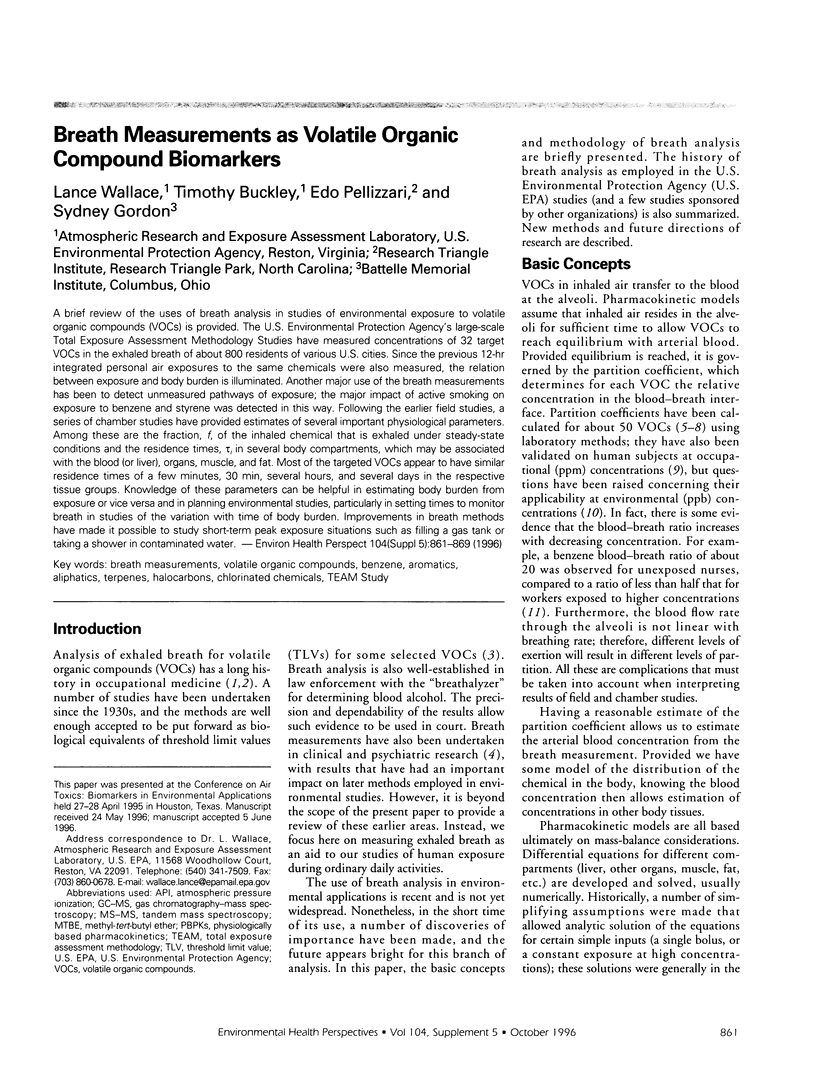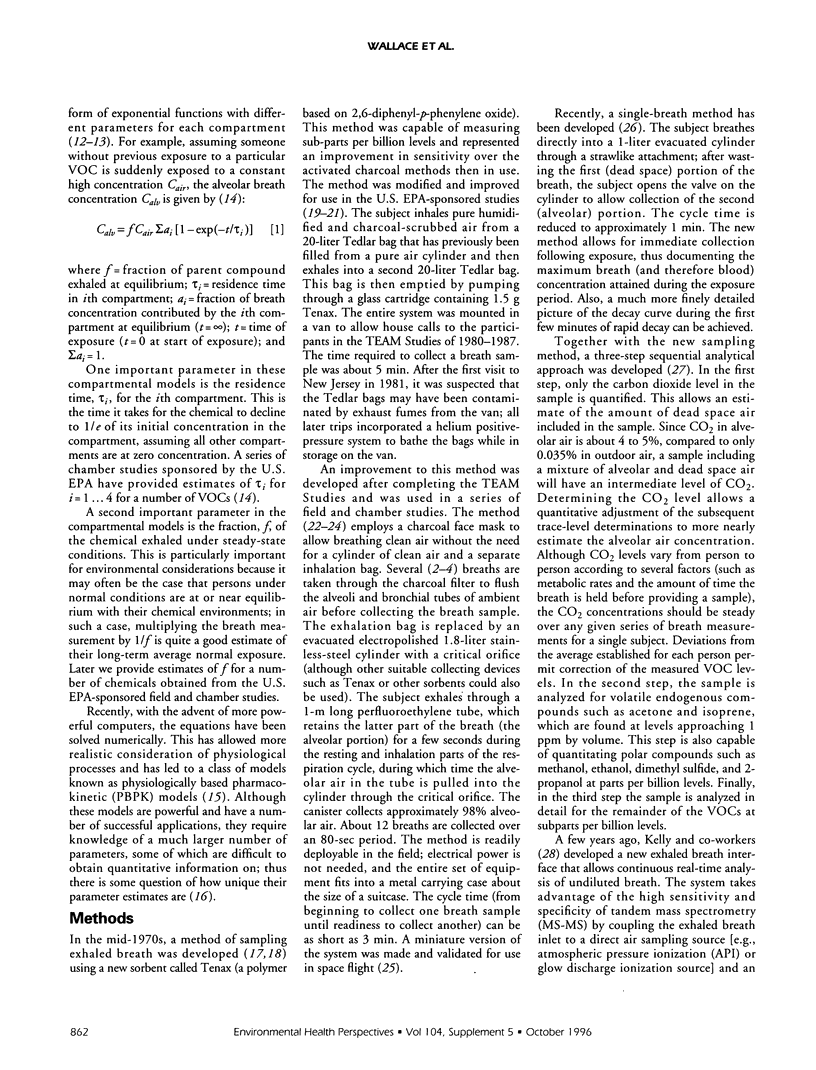Abstract
A brief review of the uses of breath analysis in studies of environmental exposure to volatile organic compounds (VOCs) is provided. The U.S. Environmental Protection Agency's large-scale Total Exposure Assessment Methodology Studies have measured concentrations of 32 target VOCs in the exhaled breath of about 800 residents of various U.S. cities. Since the previous 12-hr integrated personal air exposures to the same chemicals were also measured, the relation between exposure and body burden is illuminated. Another major use of the breath measurements has been to detect unmeasured pathways of exposure; the major impact of active smoking on exposure to benzene and styrene was detected in this way. Following the earlier field studies, a series of chamber studies have provided estimates of several important physiological parameters. Among these are the fraction, f, of the inhaled chemical that is exhaled under steady-state conditions and the residence times. tau i in several body compartments, which may be associated with the blood (or liver), organs, muscle, and fat. Most of the targeted VOCs appear to have similar residence times of a few minutes, 30 min, several hours, and several days in the respective tissue groups. Knowledge of these parameters can be helpful in estimating body burden from exposure or vice versa and in planning environmental studies, particularly in setting times to monitor breath in studies of the variation with time of body burden. Improvements in breath methods have made it possible to study short-term peak exposure situations such as filling a gas tank or taking a shower in contaminated water.
Full text
PDF








Selected References
These references are in PubMed. This may not be the complete list of references from this article.
- Aggazzotti G., Fantuzzi G., Righi E., Tartoni P., Cassinadri T., Predieri G. Chloroform in alveolar air of individuals attending indoor swimming pools. Arch Environ Health. 1993 Jul-Aug;48(4):250–254. doi: 10.1080/00039896.1993.9940368. [DOI] [PubMed] [Google Scholar]
- Ashley D. L., Bonin M. A., Cardinali F. L., McCraw J. M., Wooten J. V. Blood concentrations of volatile organic compounds in a nonoccupationally exposed US population and in groups with suspected exposure. Clin Chem. 1994 Jul;40(7 Pt 2):1401–1404. [PubMed] [Google Scholar]
- Barkley J., Bunch J., Bursey J. T., Castillo N., Cooper S. D., Davis J. M., Erickson M. D., Harris B. S., 3rd, Kirkpatrick M., Michael L. C. Gas chromatography mass spectrometry computer analysis of volatile halogenated hydrocarbons in man and his environment--A multimedia environmental study. Biomed Mass Spectrom. 1980 Apr;7(4):139–147. doi: 10.1002/bms.1200070402. [DOI] [PubMed] [Google Scholar]
- Berlin M., Gage J. C., Gullberg B., Holm S., Knutsson P., Eng C., Tunek A. Breath concentration as an index of the health risk from benzene. Studies on the accumulation and clearance of inhaled benzene. Scand J Work Environ Health. 1980 Jun;6(2):104–111. doi: 10.5271/sjweh.2625. [DOI] [PubMed] [Google Scholar]
- Bois F. Y., Woodruff T. J., Spear R. C. Comparison of three physiologically based pharmacokinetic models of benzene disposition. Toxicol Appl Pharmacol. 1991 Aug;110(1):79–88. doi: 10.1016/0041-008x(91)90291-l. [DOI] [PubMed] [Google Scholar]
- Brugnone F., Perbellini L., Faccini G. B., Pasini F., Danzi B., Maranelli G., Romeo L., Gobbi M., Zedde A. Benzene in the blood and breath of normal people and occupationally exposed workers. Am J Ind Med. 1989;16(4):385–399. doi: 10.1002/ajim.4700160406. [DOI] [PubMed] [Google Scholar]
- Entz R. C., Diachenko G. W. Residues of volatile halocarbons in margarines. Food Addit Contam. 1988 Jul-Sep;5(3):267–276. doi: 10.1080/02652038809373703. [DOI] [PubMed] [Google Scholar]
- Gargas M. L., Burgess R. J., Voisard D. E., Cason G. H., Andersen M. E. Partition coefficients of low-molecular-weight volatile chemicals in various liquids and tissues. Toxicol Appl Pharmacol. 1989 Mar 15;98(1):87–99. doi: 10.1016/0041-008x(89)90137-3. [DOI] [PubMed] [Google Scholar]
- Gordon S. M. Identification of exposure markers in smokers' breath. J Chromatogr. 1990 Jul 6;511:291–302. doi: 10.1016/s0021-9673(01)93292-3. [DOI] [PubMed] [Google Scholar]
- Gordon S. M., Szidon J. P., Krotoszynski B. K., Gibbons R. D., O'Neill H. J. Volatile organic compounds in exhaled air from patients with lung cancer. Clin Chem. 1985 Aug;31(8):1278–1282. [PubMed] [Google Scholar]
- Höld K. M., Crouch D. J., Rollins D. E., Wilkins D. G., Canfield D. V., Maes R. A. Determination of alprazolam and alpha-hydroxyalprazolam in human plasma by gas chromatography/negative-ion chemical ionization mass spectrometry. J Mass Spectrom. 1996 Sep;31(9):1033–1038. doi: 10.1002/(SICI)1096-9888(199609)31:9<1033::AID-JMS391>3.0.CO;2-H. [DOI] [PubMed] [Google Scholar]
- Jo W. K., Weisel C. P., Lioy P. J. Chloroform exposure and the health risk associated with multiple uses of chlorinated tap water. Risk Anal. 1990 Dec;10(4):581–585. doi: 10.1111/j.1539-6924.1990.tb00542.x. [DOI] [PubMed] [Google Scholar]
- Jo W. K., Weisel C. P., Lioy P. J. Routes of chloroform exposure and body burden from showering with chlorinated tap water. Risk Anal. 1990 Dec;10(4):575–580. doi: 10.1111/j.1539-6924.1990.tb00541.x. [DOI] [PubMed] [Google Scholar]
- Krotoszynski B., Gabriel G., O'Neil H. Characterization of human expired air: a promising investigative and diagnostic technique. J Chromatogr Sci. 1977 Jul;15(7):239–244. doi: 10.1093/chromsci/15.7.239. [DOI] [PubMed] [Google Scholar]
- Leung H. W., Paustenbach D. J. Application of pharmacokinetics to derive biological exposure indexes from threshold limit values. Am Ind Hyg Assoc J. 1988 Sep;49(9):445–450. doi: 10.1080/15298668891380051. [DOI] [PubMed] [Google Scholar]
- Lindstrom A. B., Highsmith V. R., Buckley T. J., Pate W. J., Michael L. C. Gasoline-contaminated ground water as a source of residential benzene exposure: a case study. J Expo Anal Environ Epidemiol. 1994 Apr-Jun;4(2):183–195. [PubMed] [Google Scholar]
- Lévesque B., Ayotte P., LeBlanc A., Dewailly E., Prud'Homme D., Lavoie R., Allaire S., Levallois P. Evaluation of dermal and respiratory chloroform exposure in humans. Environ Health Perspect. 1994 Dec;102(12):1082–1087. doi: 10.1289/ehp.102-1567469. [DOI] [PMC free article] [PubMed] [Google Scholar]
- Michael L. C., Erickson M. D., Parks S. P., Pellizzari E. D. Volatile environmental pollutants in biological matrices with a headspace purge technique. Anal Chem. 1980 Oct;52(12):1836–1841. doi: 10.1021/ac50062a014. [DOI] [PubMed] [Google Scholar]
- Morgan A., Black A., Belcher D. R. Studies on the absorption of halogenated hydrocarbons and their excretion in breath using 38 Cl tracer techniques. Ann Occup Hyg. 1972 Nov;15(2):273–283. doi: 10.1093/annhyg/15.2-4.273. [DOI] [PubMed] [Google Scholar]
- O'Neill H. J., Gordon S. M., O'Neill M. H., Gibbons R. D., Szidon J. P. A computerized classification technique for screening for the presence of breath biomarkers in lung cancer. Clin Chem. 1988 Aug;34(8):1613–1618. [PubMed] [Google Scholar]
- Pellizzari E. D., Hartwell T. D., Harris B. S., 3rd, Waddell R. D., Whitaker D. A., Erickson M. D. Purgeable organic compounds in mother's milk. Bull Environ Contam Toxicol. 1982 Mar;28(3):322–328. doi: 10.1007/BF01608515. [DOI] [PubMed] [Google Scholar]
- Pellizzari E. D., Wallace L. A., Gordon S. M. Elimination kinetics of volatile organics in humans using breath measurements. J Expo Anal Environ Epidemiol. 1992 Jul-Sep;2(3):341–355. [PubMed] [Google Scholar]
- Perbellini L., Faccini G. B., Pasini F., Cazzoli F., Pistoia S., Rosellini R., Valsecchi M., Brugnone F. Environmental and occupational exposure to benzene by analysis of breath and blood. Br J Ind Med. 1988 May;45(5):345–352. doi: 10.1136/oem.45.5.345. [DOI] [PMC free article] [PubMed] [Google Scholar]
- Phillips M. Breath tests in medicine. Sci Am. 1992 Jul;267(1):74–79. doi: 10.1038/scientificamerican0792-74. [DOI] [PubMed] [Google Scholar]
- Pleil J. D., Lindstrom A. B. Measurement of volatile organic compounds in exhaled breath as collected in evacuated electropolished canisters. J Chromatogr B Biomed Appl. 1995 Mar 24;665(2):271–279. doi: 10.1016/0378-4347(94)00545-g. [DOI] [PubMed] [Google Scholar]
- Ramsey J. C., Andersen M. E. A physiologically based description of the inhalation pharmacokinetics of styrene in rats and humans. Toxicol Appl Pharmacol. 1984 Mar 30;73(1):159–175. doi: 10.1016/0041-008x(84)90064-4. [DOI] [PubMed] [Google Scholar]
- Raymer J. H., Pellizzari E. D., Thomas K. W., Cooper S. D. Elimination of volatile organic compounds in breath after exposure to occupational and environmental microenvironments. J Expo Anal Environ Epidemiol. 1991 Oct;1(4):439–451. [PubMed] [Google Scholar]
- Raymer J. H., Thomas K. W., Cooper S. D., Whitaker D. A., Pellizzari E. D. A device for sampling of human alveolar breath for the measurement of expired volatile organic compounds. J Anal Toxicol. 1990 Nov-Dec;14(6):337–344. doi: 10.1093/jat/14.6.337. [DOI] [PubMed] [Google Scholar]
- Raymer J. H., Thomas K. W., Pellizzari E. D., Whitaker D. A., Cooper S. D., Limero T., James J. T. A breath sampling device for measuring human exposure to volatile organic compounds in microgravity. Aviat Space Environ Med. 1994 Apr;65(4):353–360. [PubMed] [Google Scholar]
- Sato A., Nakajima T. A structure-activity relationship of some chlorinated hydrocarbons. Arch Environ Health. 1979 Mar-Apr;34(2):69–75. doi: 10.1080/00039896.1979.10667371. [DOI] [PubMed] [Google Scholar]
- Sato A., Nakajima T. Partition coefficients of some aromatic hydrocarbons and ketones in water, blood and oil. Br J Ind Med. 1979 Aug;36(3):231–234. doi: 10.1136/oem.36.3.231. [DOI] [PMC free article] [PubMed] [Google Scholar]
- Sato A., Nakajima T. Pharmacokinetics of organic solvent vapors in relation to their toxicity. Scand J Work Environ Health. 1987 Apr;13(2):81–93. doi: 10.5271/sjweh.2075. [DOI] [PubMed] [Google Scholar]
- Thomas K. W., Pellizzari E. D., Cooper S. D. A canister-based method for collection and GC/MS analysis of volatile organic compounds in human breath. J Anal Toxicol. 1991 Mar-Apr;15(2):54–59. doi: 10.1093/jat/15.2.54. [DOI] [PubMed] [Google Scholar]
- Thomas K. W., Pellizzari E. D., Perritt R. L., Nelson W. C. Effect of dry-cleaned clothes on tetrachloroethylene levels in indoor air, personal air, and breath for residents of several New Jersey homes. J Expo Anal Environ Epidemiol. 1991 Oct;1(4):475–490. [PubMed] [Google Scholar]
- Thompson K. M., Evans J. S. Workers' breath as a source of perchloroethylene (Perc) in the home. J Expo Anal Environ Epidemiol. 1993 Oct-Dec;3(4):417–430. [PubMed] [Google Scholar]
- Travis C. C., Bowers J. C. Protein binding of benzene under ambient exposure conditions. Toxicol Ind Health. 1989 Dec;5(6):1017–1024. doi: 10.1177/074823378900500609. [DOI] [PubMed] [Google Scholar]
- Uhler A. D., Diachenko G. W. Volatile halocarbon compounds in process water and processed foods. Bull Environ Contam Toxicol. 1987 Oct;39(4):601–607. doi: 10.1007/BF01698451. [DOI] [PubMed] [Google Scholar]
- Wallace L. A., Pellizzari E. D., Hartwell T. D., Sparacino C., Whitmore R., Sheldon L., Zelon H., Perritt R. The TEAM (Total Exposure Assessment Methodology) Study: personal exposures to toxic substances in air, drinking water, and breath of 400 residents of New Jersey, North Carolina, and North Dakota. Environ Res. 1987 Aug;43(2):290–307. doi: 10.1016/s0013-9351(87)80030-0. [DOI] [PubMed] [Google Scholar]
- Wallace L. A., Pellizzari E., Hartwell T., Rosenzweig M., Erickson M., Sparacino C., Zelon H. Personal exposure to volatile organic compounds. I. Direct measurements in breathing-zone air, drinking water, food, and exhaled breath. Environ Res. 1984 Oct;35(1):293–319. doi: 10.1016/0013-9351(84)90137-3. [DOI] [PubMed] [Google Scholar]
- Wallace L., Pellizzari E., Gordon S. A linear model relating breath concentrations to environmental exposures: application to a chamber study of four volunteers exposed to volatile organic chemicals. J Expo Anal Environ Epidemiol. 1993 Jan-Mar;3(1):75–102. [PubMed] [Google Scholar]
- Wallace L., Pellizzari E., Hartwell T. D., Perritt R., Ziegenfus R. Exposures to benzene and other volatile compounds from active and passive smoking. Arch Environ Health. 1987 Sep-Oct;42(5):272–279. doi: 10.1080/00039896.1987.9935820. [DOI] [PubMed] [Google Scholar]


